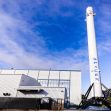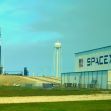The Federal Aviation Administration (FAA) is headed to federal court after being sued by numerous environmental groups due to claims of not conducting enough research into the recent SpaceX launch. The plaintiffs include the American Bird Conservancy, Center for Biological Diversity, Surfrider Foundation, Save RGV, and the Corrizzo/Comcrudo Nation of Texas.
The FAA was in discussions with SpaceX over how to safely proceed with its April 20 launch for over a year.
SpaceX launched its enormous Starship on April 20 from its private launch pad in South Texas. After four minutes in flight, the giant rocket exploded over the Gulf of Mexico.
The suit says the area where the SpaceX rocket exploded is part of an “essential habitat” that includes numerous species that are protected by federal law.
The environmentalist groups claim in their lawsuit that the FAA authorized the launch, which was planned by SpaceX to include the rocket explosion, “without complying with bedrock federal environmental law, without fully analyzing the significant environmental and community impacts of the Space X launch program — including destruction of some of the most vital migratory bird habitat in North America — and without requiring mitigation sufficient to offset those impacts.”
The environmentalist organizations, including the Center for Biological Diversity, claim the massive explosion over the Gulf of Mexico may lead to damage to the natural environment and protected species, including the ocelot. In a statement after the suit was filed in Washington D.C. federal court, Jared Margolis, the senior attorney for the Center of Biological Diversity, said that the FAA must research the impact of such large explosions over Earth, as more and more space crafts are launched by private companies
“It’s vital that we protect life on Earth even as we look to the stars in this modern era of spaceflight,” said Margolis.
SpaceX has announced that another launch is in the very near future, perhaps in six to eight weeks, as SpaceX founder and CEO Elon Musk has said.
Margolis said that the first SpaceX explosion in April proves their case for the necessity of the FAA increasing its investigations on the impact large explosions have upon the environment and endangered species.
Prior to the April SpaceX Starship explosion, the FAA reported that the launch would be approved and would pass federal standards for environmental impact if the private company complied with 75 “mitigating actions.”
Some of the mitigating actions SpaceX needed to implement, as noted by the FAA, included hiring a “qualified biologist” to study the impact upon all wildlife in the area; creating public warnings about the upcoming launch and the possible dangers including the sound of sonic booms, and plans to remove and clean any shrapnel from explosions from “sensitive” wildlife habitats.
Despite eventually exploding over the Gulf of Mexico, the FAA’s report before the flight stated that the launch “would not significantly affect the quality of the human environment.” The FAA findings before the April explosion meant that the agency would not investigate the then-upcoming launch further.
Margolis, in a statement for the plaintiffs, said the FAA should not have approved the flight until a deeper investigation had occurred.
“They just proved our point here,” Margolis said, regarding the lawsuit against the FAA. “What ended up occurring was exactly what we expected. There’s all kinds of environmental harm that’s clearly an issue and needs to be fully considered, and they didn’t consider it.”
One of the changes the environmental groups demand is that the FAA mandate that SpaceX and other future flights use more water so that it will cool down the launch pad, which exploded in the April launch. Other environmental issues in the lawsuit include the danger to birds in the area, who use the skies there for their migration.
“It’s an incredibly important area for birds,” Margolis said. “There’s an incredible amount of heat and light from the launches even when they don’t go wrong.” Local debris is also a major issue that may harm the environment, as noted in the suit. As trucks arrive to clean up the local debris, such as concrete and metal, the environmental groups believe this will harm local wildlife.
The US Fish and Wildlife Service issued a statement about the explosion, saying that it was working with the FAA and SpaceX to “provide on-the-ground guidance to minimize further impacts and reduce long-term damages to natural resources.” In the statement, the US Fish and Wildlife Service said it was investigating the area impacted by the launch.
“Following the launch and mid-air explosion, Cameron County closed Boca Chica Beach and State Highway 4 for 48 hours due to launch pad safety concerns, which prevented Service staff from accessing refuge-owned and managed land,” the statement states. “Once the closure ended, Service staff began their assessment of the launch impacts at 10 a.m. April 22, 2023.”
Details of some of the damage done were released by the US Fish and Wildlife Service as well, with the agency referring to “numerous large concrete chunks, stainless steel sheets, metal and other objects hurled thousands of feet away along with a plume cloud of pulverized concrete that deposited material up to 6.5 miles northwest of the pad site.”
The wildlife agency also noted that local residents reported “a strange dust” after the explosion. The data shared by the agency included the data that “Although no debris was documented on refuge fee-owned lands, staff documented approximately 385 acres of debris on SpaceX’s facility and at Boca Chica State Park, which is leased by the Service and managed as a component of the Lower Rio Grande National Wildlife Refuge. Additionally, a 3.5-acre fire started south of the pad site on Boca Chica State Park land. At this time, no dead birds or wildlife have been found on refuge-owned or managed lands.”
In response to the gargantuan SpaceX explosion over the Gulf of Mexico, the FAA said in an email to CNN that it will “determine the root cause of the event and identify corrective actions the operator must implement to avoid a recurrence,” and that “SpaceX is responsible for its implementation and for local, state and federal compliance requirements.”
Musk, on Twitter doing a public chat, belittled the damage done by the explosion of his SpaceX Starship.
“Look at an aerial picture of the area and — apart from the area around the launch stand — tell me where things are damaged. … I think you can’t even see it at this point. To the best of our knowledge, there has not been any meaningful damage to the environment,” Musk said.






